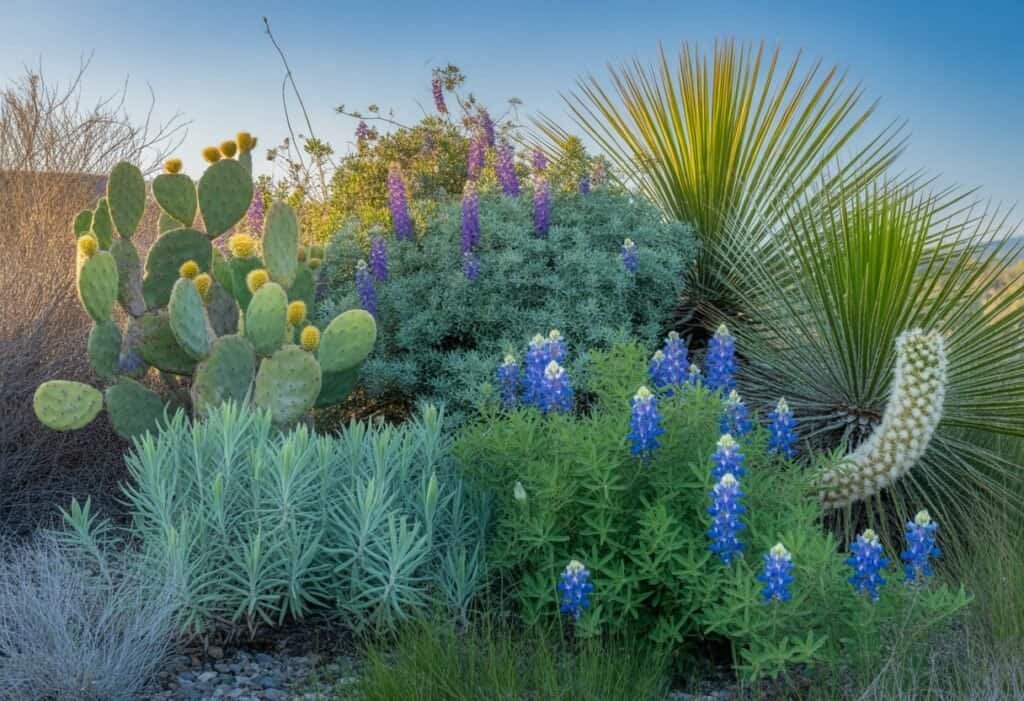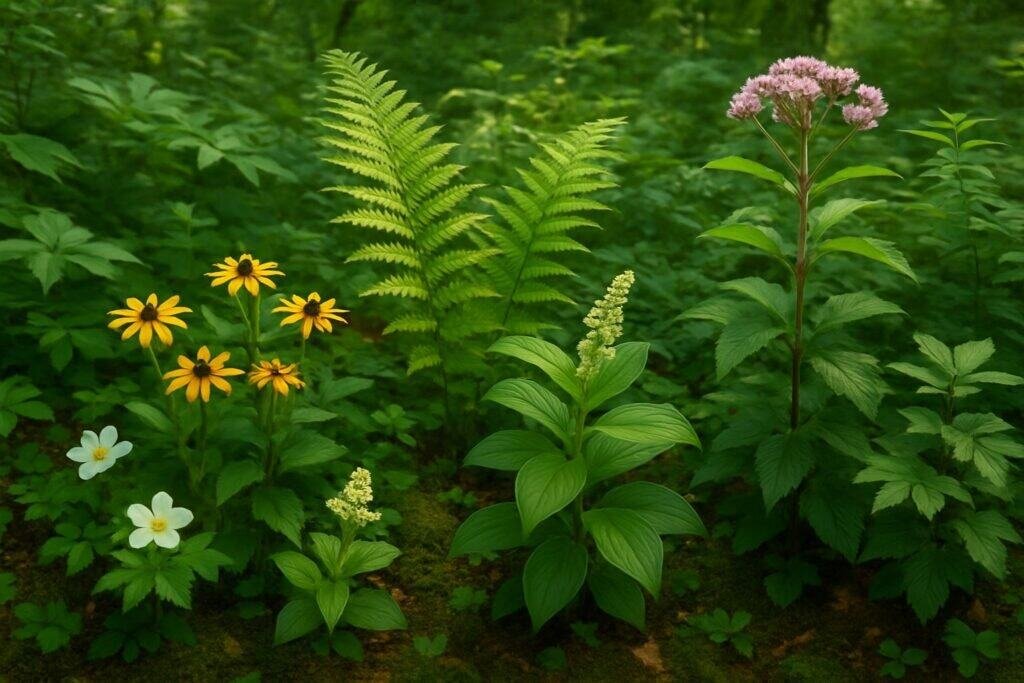San Antonio’s native plants offer a beautiful and sustainable way to garden in South Texas. These plants have adapted to the region’s unique climate, requiring less water and maintenance than non-native species.
Incorporating native plants in your San Antonio garden helps conserve water, support local wildlife, and create a landscape that thrives in our challenging conditions.
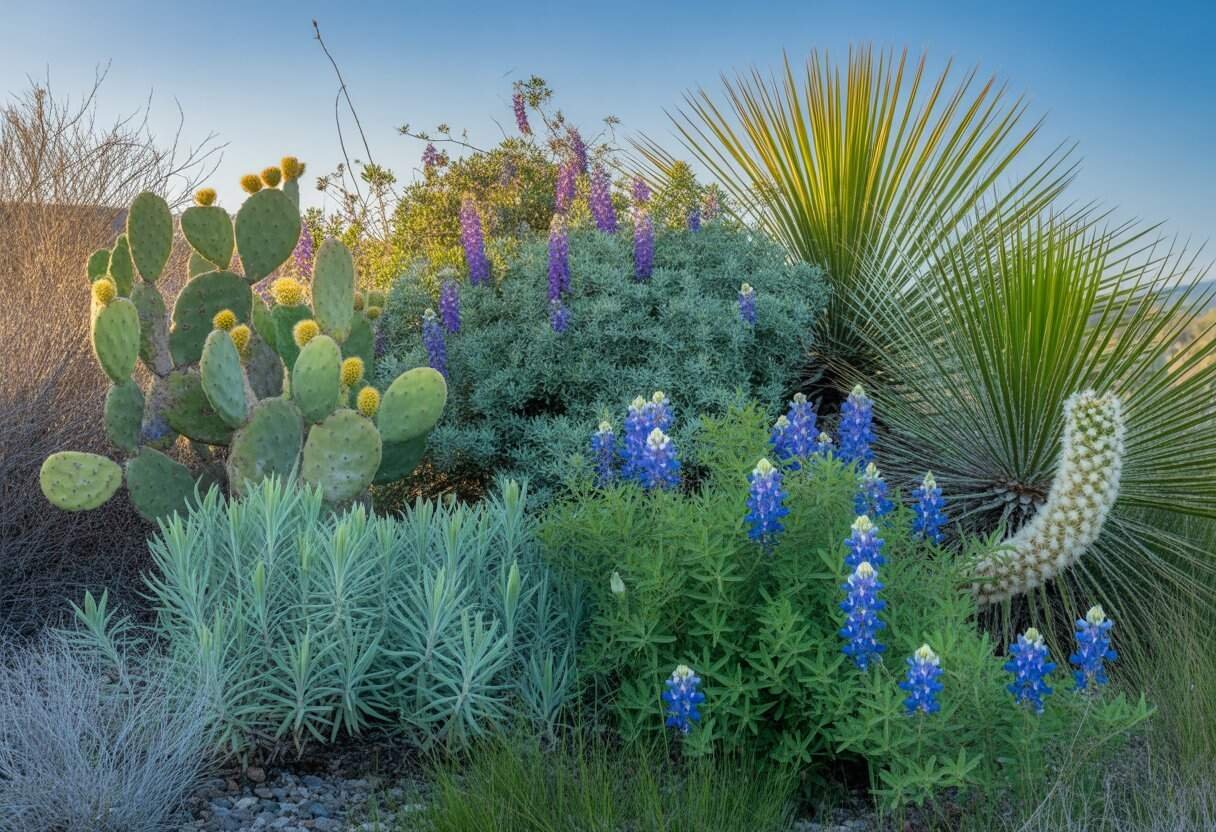
From colorful wildflowers to drought-resistant shrubs, San Antonio offers a diverse array of native plant options. These plants can withstand the region’s hot summers and occasional freezes while providing food and habitat for local birds, butterflies, and beneficial insects.
Many native plants also showcase the unique natural heritage of the Texas Hill Country.
Key Takeaways
- Native plants in San Antonio need less water and maintenance while supporting local wildlife and pollinators.
- The Texas Hill Country ecosystem features diverse plant species adapted to both drought conditions and occasional freezes.
- Local resources like the San Antonio Botanical Garden offer education and plant selections for home gardeners interested in native landscaping.
Understanding San Antonio’s Unique Ecosystems
San Antonio sits at the intersection of several distinct ecological regions. Each region has its own plant communities shaped by geology, soil, and rainfall patterns.
These diverse ecosystems create unique opportunities for native plant gardening.
Hill Country and Edwards Plateau
The Hill Country and Edwards Plateau form the northwestern edge of San Antonio. This region features thin, alkaline soils over limestone bedrock.
Annual rainfall averages 30-34 inches, creating a semi-arid environment. Native plants here have deep root systems and drought-resistant features.
Mountain laurel, Texas persimmon, and Ashe juniper thrive in this rocky terrain. The Edwards Plateau hosts diverse oak species including live oak, Spanish oak, and shin oak.
These trees provide habitat for wildlife and help prevent erosion on the region’s slopes. The Guadalupe River and its tributaries cut through this limestone landscape, creating microhabitats where moisture-loving plants like sycamore and bald cypress grow along the waterways.
Blackland Prairie and Post Oak Savanna
The eastern portions of San Antonio feature the rich, dark soils of the Blackland Prairie and the sandy loams of the Post Oak Savanna. These areas receive slightly more rainfall, averaging 32-36 inches annually.
The Northern Blackland Prairie once supported tallgrasses like big bluestem, Indiangrass, and switchgrass growing 5-8 feet tall. Today, remnants of this ecosystem host wildflowers including coneflowers, gayfeather, and black-eyed Susans.
Post Oak Savanna areas feature scattered groves of post oak and blackjack oak with prairie openings between. These open woodlands support understory plants like American beautyberry and turk’s cap.
Gardeners in these areas benefit from deeper soils that retain moisture better than Hill Country locations.
Limestone Canyons and Spring-Fed Creeks
San Antonio’s limestone canyons and spring-fed creeks create microclimates with higher moisture and protection from harsh sun and winds. The Edwards Aquifer feeds crystal-clear springs throughout the region.
Ferns, sedges, and water-loving plants flourish along creek banks. Sycamore, bald cypress, and pecan trees form cooling canopies over these waterways.
The limestone cut plains feature dramatic changes in elevation. These areas host specialized plants like the endangered Texas wild rice and golden-cheeked warbler habitat.
Canyon slopes support Texas madrone, escarpment black cherry, and bigtooth maple. Spring-fed creeks maintain consistent temperatures year-round, supporting unique communities of aquatic plants and providing reliable water sources during drought periods.
Benefits of Native Plants for San Antonio
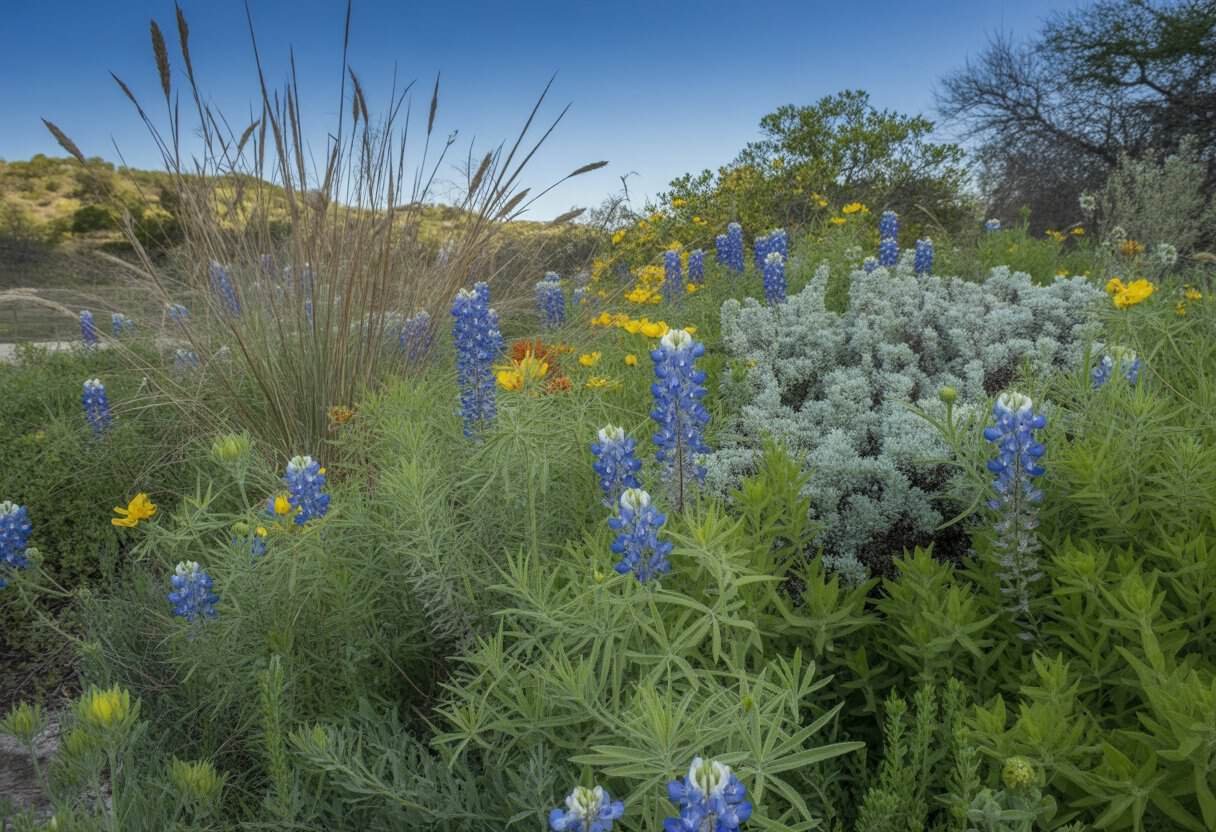
Native plants offer many advantages for San Antonio landscapes. These locally-adapted species match our regional climate and soil conditions.
Supporting Pollinators and Wildlife
Native plants form the foundation of San Antonio’s local ecosystem. They provide food and habitat for native wildlife that has evolved alongside these plants.
Monarch butterflies rely on native milkweed species during their migration through Texas. Without these specific plants, their populations would decline.
Hummingbirds favor native salvias and trumpet vines for their nectar. These birds have beaks that match the shapes of these native flowers.
Bees, including many native species, collect pollen and nectar from plants like sunflowers, purple coneflower, and golden tickseed. A single native oak tree can support hundreds of butterfly and moth species during their larval stages.
By planting natives, San Antonio residents create habitats that help wildlife navigate through urban areas.
Conserving Water and Adapting to Drought
Native plants have adapted to San Antonio’s climate over centuries. They have efficient root systems that need minimal supplemental water once established.
During drought, natives like Texas sage and agave can survive with little or no irrigation. This resilience comes from adaptations to the region’s natural rainfall patterns.
Water bills drop when landscapes feature drought-tolerant natives instead of thirsty exotic plants. Most natives need watering only during establishment and extreme drought.
The deep root systems of plants like little bluestem grass help water penetrate soil more effectively. This reduces runoff and erosion during heavy rain.
Native groundcovers such as frogfruit and horseherb provide green coverage without the high water needs of traditional turf grass.
Promoting Biodiversity
San Antonio’s native plant communities support complex webs of life. Each native species plays a unique role in the ecosystem.
A diverse native garden can host many more species of birds, butterflies, and beneficial insects than a traditional landscape. This biodiversity helps control pest populations naturally.
Flame acanthus, lantana, and other flowering natives attract predatory insects that feed on garden pests. This creates balance without chemical interventions.
Native plant diversity also improves soil health through varied root structures and organic matter. Different plants support different soil microorganisms.
Preserving genetic diversity among native plant populations helps species adapt to changing environmental conditions.
Low Maintenance and Landscaping Advantages
Native plants require less care than non-native ornamentals. They thrive in local soil conditions without amendments or fertilizers.
Once established, most natives need pruning only for appearance. This reduces yard work and maintenance costs.
Native plants resist local diseases and pests better than exotic species. Texas mountain laurel and cenizo rarely suffer from the pest problems that affect non-native ornamentals.
The textures and colors of natives like gulf muhly grass and blackfoot daisy create authentic regional character in landscapes. These plants connect gardens to San Antonio’s natural heritage.
Native plant landscapes can increase property values by creating distinctive, attractive outdoor spaces. Their year-round interest and low maintenance requirements appeal to potential buyers.
Featured San Antonio Native Plants
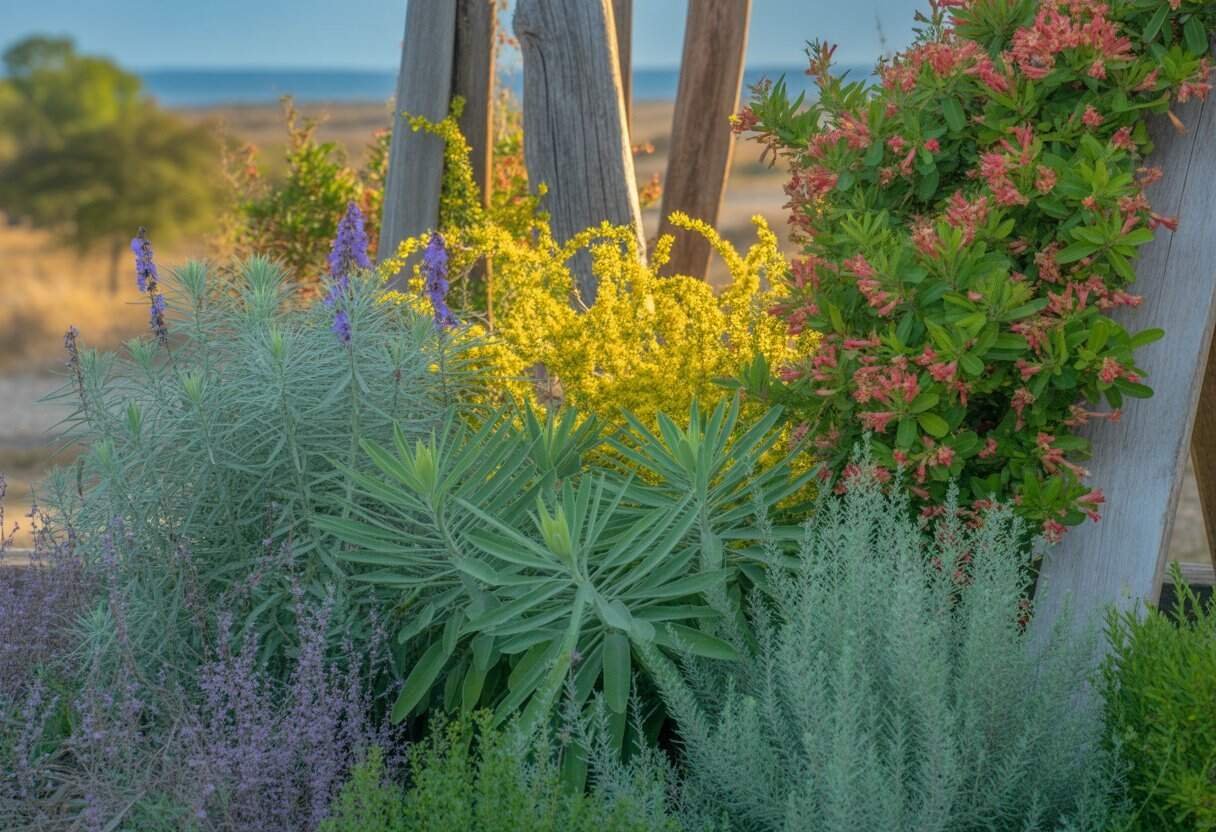
San Antonio’s climate supports a range of native plants that thrive in the region’s hot summers and mild winters. These plants have adapted to local soil conditions and rainfall patterns.
Trees and Woody Plants
Live Oak (Quercus fusiformis) is one of San Antonio’s iconic trees. These evergreens can live for centuries and provide essential shade in hot summer months.
Their acorns support local wildlife. Ashe Juniper plays a crucial role in the Hill Country ecosystem.
These hardy trees provide nesting sites for the endangered golden-cheeked warbler. Bald Cypress (Taxodium distichum) thrives along waterways, displaying distinctive “knees” and feathery foliage.
In fall, their needles turn a rusty orange before dropping. Sycamores (Platanus occidentalis) have mottled white and brown bark.
These large trees excel in riparian areas and can reach impressive heights.
Native Shrubs
Yaupon holly grows naturally throughout San Antonio. This evergreen shrub produces bright red berries in winter that attract birds.
It can be shaped as a hedge, small tree, or left in its natural form. American Beautyberry delivers purple berry clusters in fall.
These berries persist after leaves drop, adding winter interest to gardens. Wildlife appreciate this food source during scarce months.
Flame Acanthus features tubular orange-red flowers that attract hummingbirds and butterflies. This drought-resistant shrub blooms throughout summer and into fall.
Texas Sage (Leucophyllum frutescens) has silvery foliage and purple flowers after rain events. Its sudden flowering often precedes weather changes.
Grasses and Groundcovers
Little Bluestem (Schizachyrium scoparium) displays blue-green stems in summer that turn reddish-copper in fall. This clumping grass reaches about 3 feet tall and provides winter interest.
Indian Grass (Sorghastrum nutans) forms golden plumes in late summer. Its height makes it perfect for background plantings or naturalized areas.
Switchgrass (Panicum virgatum) offers airy seed heads and helps control erosion. This grass tolerates both dry conditions and occasional flooding.
Frogfruit serves as an excellent native groundcover for sunny spots. Its tiny white flowers attract small pollinators, and it can handle light foot traffic.
Herbaceous Flowering Plants
Texas Lantana blooms with orange, yellow, and red flowers from spring until frost. This perennial attracts butterflies and thrives in full sun.
Mealy Blue Sage produces spikes of sky-blue flowers throughout the growing season. Its drought tolerance makes it perfect for water-wise gardens.
Black-eyed Susan brightens gardens with golden-yellow petals and dark centers. These flowers self-seed readily and naturalize in sunny areas.
Texas Coneflower stands tall with drooping yellow petals and raised central cones. This perennial attracts beneficial insects and provides seeds for birds in fall.
Its drought tolerance makes it ideal for low-maintenance gardens.
San Antonio Wildflowers and Seasonal Color
San Antonio’s climate supports many native wildflowers that bring vibrant colors to landscapes throughout the year. These native blooms support local wildlife and use less water than non-native alternatives.
Spring Wildflower Displays
Spring transforms San Antonio into a colorful paradise of native blooms. Bluebonnets, the Texas state flower, create blue carpets from March through April.
These iconic flowers thrive in full sun and well-drained soil. Indian paintbrush adds red and orange alongside bluebonnets in natural areas.
Pink evening primrose offers delicate pink blooms that open in late afternoon and persist through spring. Black-eyed Susans provide golden yellow flowers that attract pollinators.
These hardy plants tolerate both drought and poor soil conditions. For home gardens, Texas winecup delivers magenta flowers that spread as ground cover.
Prairie verbena creates purple clusters that bloom repeatedly when deadheaded. These spring wildflowers establish best when planted in fall, allowing root systems to develop before the growing season begins.
Milkweeds and Monarch Attraction
Milkweeds support monarch butterflies during their migration through San Antonio. Antelope horns milkweed (Asclepias asperula) thrives in sunny, well-drained locations and produces curved seed pods.
Green milkweed (Asclepias viridis) has pale green flowers and grows well in various soils. Butterflyweed (Asclepias tuberosa) displays bright orange blooms that attract monarchs and other pollinators.
These native milkweeds are the only host plants for monarch caterpillars. Monarchs lay eggs only on milkweed species, and their caterpillars eat the leaves.
Plant milkweeds in groups of three or more in full sun for best results. Avoid using pesticides near these plants because chemicals can harm monarch larvae.
Deer Resistant and Shade Tolerant Options
Many San Antonio gardeners struggle with deer browsing and shaded areas. Several native plants help solve both issues.
Turk’s cap grows in part to full shade and produces red flowers that deer usually avoid. This plant attracts hummingbirds and tolerates drought once established.
Autumn sage (Salvia greggii) has colorful blooms and grows well in part sun. Its aromatic leaves help keep deer away.
Columbine provides delicate spring flowers and tolerates deer in shadier spots. Cedar sage brings bright red blooms to woodland gardens and shaded areas.
Flame acanthus tolerates partial shade and produces orange-red tubular flowers for hummingbirds. Its woody structure and bitter taste make it less appealing to deer.
Esperanza thrives in sunny spots with bright yellow bell-shaped flowers that deer rarely damage.
Landscaping and Gardening with Native Plants
Native plants offer many benefits for San Antonio landscapes. They create beautiful gardens and support local wildlife while conserving water.
Designing for Wildlife and Pollinators
Native plants attract pollinators and wildlife to your garden. Butterfly weed, flame acanthus, and Gregg’s mistflower draw butterflies and bees that help pollinate your yard.
Birds like cardinals and mockingbirds visit plants with berries such as possumhaw holly and Texas persimmon. These plants provide food and shelter for birds year-round.
Plant in clusters of 3-5 of the same species to create visual impact and help pollinators find food. Use different plant heights for layered designs.
Tall grasses like Lindheimer muhly work as a backdrop. Shorter plants like blackfoot daisy fit well in front.
Soil, Sun, and Water Requirements
San Antonio’s alkaline, rocky soil supports many native plants. Species like Mexican feathergrass and cenizo thrive in limestone-rich soils without amendments.
Most native plants prefer full sun, especially those from the Hill Country. Mealy blue sage and autumn sage bloom best with at least six hours of direct sunlight daily.
Water needs depend on the plant:
| Plant Type | Watering Needs After Establishment |
|---|---|
| Drought-tolerant | Once every 2-3 weeks |
| Moderate | Weekly in summer |
| Moisture-loving | Twice weekly |
New plants need regular watering during their first year. After they establish, most natives need little extra water, making them ideal for the hot climate.
Choosing Plants for Local Conditions
Choose plants that match your specific location in the San Antonio area. New Braunfels and Salado gardens may need different selections than urban yards.
Consider soil depth, drainage, and exposure when picking plants. Shallow soils need shallow-rooted plants, low areas need flood-tolerant plants, and windy sites need sturdy plants like Texas sage.
Many ranches use native grasses like little bluestem for erosion control and grazing. These grasses also enhance landscapes.
Look for plant tags labeled “Texas Native” or “Native to Central Texas.” Local nurseries often group native plants together for easier shopping.
Native plant sales by conservation groups offer rare varieties not found in commercial nurseries.
Conservation, Threats, and Sustainable Practices
San Antonio’s native plants face threats from non-native species, changes in fire patterns, and agricultural pressure.
Invasive Species Management
Invasive plants threaten San Antonio’s native vegetation. Species like King Ranch bluestem, Johnson grass, and Chinese privet outcompete natives for resources and space.
Conservation groups regularly remove invasive plants from natural areas and roadsides. Early detection and rapid response help control new invasions.
Use chemical control carefully to avoid harming native species. Mechanical removal works for small infestations but needs follow-up.
Planting diverse native species builds resilient ecosystems. Native plant gardens and restoration projects support local wildlife and resist invasives.
Fire Suppression and Habitat Change
Fire once maintained San Antonio’s native ecosystems by keeping woody plants in check and supporting prairie species.
Modern fire suppression allows juniper and other woody species to spread, reducing plant diversity.
Preserves now use prescribed fire to restore balance. Controlled burns stimulate dormant native seeds, recycle nutrients, and reduce wildfire risks.
Overgrazing and Agricultural Pressures
Agricultural development has changed much of San Antonio’s landscape. Overgrazing by livestock removes native plants and compacts soil, making recovery difficult.
Poor grazing practices cause erosion and open space for invasive species. Restoration takes significant effort in these areas.
Sustainable practices help protect native plants:
- Rotational grazing allows land to recover
- Conservation easements preserve critical habitats
- Native seed banks maintain genetic diversity
- Demonstration gardens showcase native plants
Agricultural lands can support native plants with buffer zones along waterways and conservation areas on farms and ranches. These practices protect biodiversity and support agriculture.
Resources, Events, and Further Learning
San Antonio offers many ways to learn about native plants through local organizations, educational gardens, and annual events.
Local Organizations and Gardens
The San Antonio Native Plant Society hosts monthly meetings with expert speakers and organizes field trips. Their website provides planting guides for the region’s soil and climate.
Texas Parks and Wildlife maintains demonstration gardens throughout the city and provides free identification guides. Their staff helps homeowners convert lawns to native landscapes.
Pollinatives, a local non-profit, creates urban habitats for pollinators. They run a native plant nursery where residents can buy hard-to-find species and get advice from volunteers.
The San Antonio Botanical Garden features native plant collections organized by ecosystem. Visitors can see mature specimens in natural settings.
Annual Symposiums and Educational Programs
The Fall 2025 Symposium on Texas Native Plants will happen September 12-14 at the San Antonio Convention Center. Experts, nursery owners, and enthusiasts gather for workshops, plant sales, and networking.
Native Plant Week in October features tours of native landscapes, seed exchanges, and hands-on planting events.
Lady Bird Johnson Wildflower Center offers monthly webinars on seasonal native plant care. Their online database helps gardeners pick species for their sites.
Master Naturalist Training Programs run twice a year and teach about local ecosystems, plant identification, and sustainable landscaping.
Frequently Asked Questions
San Antonio’s climate supports many native plants that thrive with little care. These plants save water and create habitats for wildlife.
What are the best drought-tolerant plants recommended for San Antonio landscaping?
Texas sage (Leucophyllum frutescens) is a top drought-tolerant shrub with silvery leaves and purple blooms. It needs almost no water once established.
Mexican feathergrass (Nassella tenuissima) brings graceful movement to gardens and survives on minimal water. Its golden seed heads catch the light.
Blackfoot daisy (Melampodium leucanthum) forms a low carpet of white flowers that bloom most of the year. It thrives in poor, rocky soil.
Cenizo and esperanza handle the hottest summers without extra water. Their bright flowers appear after rain, giving cenizo the nickname “barometer bush.”
Where can one find native plants for sale specifically in San Antonio area?
The San Antonio Botanical Garden holds seasonal plant sales with many native species. Staff help with plant selection and care.
Rainbow Gardens has two San Antonio locations with dedicated native plant sections. They offer Texas natives suited for local conditions.
Milberger’s Nursery stocks drought-resistant natives and shares gardening tips through weekly shows.
The Native Plant Society of Texas – San Antonio chapter hosts plant sales and swaps with rare native varieties.
Which native plants are ideal for low-maintenance gardens in San Antonio?
Gregg’s mistflower (Conoclinium greggii) attracts butterflies with blue-purple blooms and needs little care. It spreads naturally in gardens.
Texas mountain laurel (Sophora secundiflora) grows into a small tree with fragrant purple flowers. It needs no extra water once established.
Turk’s cap (Malvaviscus arboreus) thrives in sun or shade with bright red flowers for hummingbirds. It returns each spring with no maintenance.
Mealy blue sage (Salvia farinacea) produces blue flower spikes from spring through fall. It reseeds easily and needs no fertilizer.
Can you list nurseries that specialize in San Antonio indigenous plant species?
Fanick’s Garden Center has specialized in native and adapted plants since 1939. Their experience helps local gardeners succeed.
Shades of Green focuses on plants that thrive in the local climate. Their inventory emphasizes sustainability and water conservation.
The Natural Gardener in nearby Austin offers many natives suitable for San Antonio. Their gardens show how these plants perform in landscapes.
Medina Garden Nursery carries hard-to-find native species and grows many plants on-site for local adaptation.
What are the characteristics of flora that thrive well in the San Antonio climate?
Plants that succeed in San Antonio often have deep roots to access underground moisture. This helps them survive long dry periods.
Many native plants have silvery or gray foliage that reflects sunlight and reduces water loss. Waxy or small leaves also help minimize evaporation.
Plants like yucca and agave store water in thick leaves. San Antonio natives often go dormant during extreme conditions and quickly revive when weather improves.
How can the SAWS Plant Program benefit gardeners interested in water-conserving landscapes in San Antonio?
The San Antonio Water System (SAWS) offers rebates for replacing grass with approved water-saving plants. Homeowners can receive up to $400 for landscape conversions.
SAWS gives free landscape consultations to help homeowners design water-efficient gardens. Their experts recommend native plants for each situation.
The WaterSaver Coupon program offers vouchers for purchasing approved drought-tolerant plants. This program runs during spring and fall planting seasons.
SAWS maintains demonstration gardens throughout the city. Gardeners can visit these gardens to see mature native plants and get ideas for their own landscapes.

